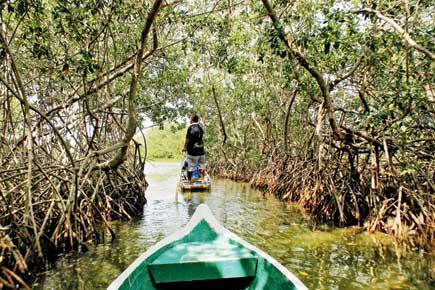While humankind continues to dig its own grave with greed, artists are more like mud lobsters, digging solely to make the world fertile


As we trudged through the swampy, marshy stretch surrounded by mangroves, I felt like I had been touring my own subconscious. Pic for Representation

ADVERTISEMENT
We chose to pursue the same scenic route I'd stumbled upon last evening, when I had enticed Asli to consider a sunset picnic along the river, just past the Calvim bridge. We watched the sun set framed against the ferry-replacing architectonic, and had realised, after a quick consultation with Google maps that the road ahead could take us right through to Bicholim, past the level crossing, until we would finally arrive at the Chorao ferry point, adjacent to which is the bird sanctuary. It was 8.30 am when we reached, and unwisely decided to walk through the sanctuary first and then consider taking the boat around the mangroves. I even wore my special stole with light gold-embossed birds gifted to me by the artist, Reena Kallat. Sadly, we saw no winged creatures, just a whole bunch of crabs. But that is not to suggest in any way that the trip wasn't fruitful. I have been having my fair fill of bird watching at Orijit Sen's property in Corjeum. I was more interested in the ecosystem of the sanctuary.
Later, when we were returning, having pursued a different path, having taken the ferry from Panjim to Betim and then proceeding towards Aldona from underneath the bridge, thus skirting along the River Mandovi for a good couple of kilometres, I told Asli how as we trudged through the swampy, marshy stretch surrounded by mangroves, I felt like I had been touring my own subconscious. The stilt roots that seem to stretch everywhere, sometimes entwining around themselves, felt like a structure suspended in space. The birds, though missing from view, were definitely present, as were the crocodiles. I felt the aura of each and every creature that inhabited that space. It was humankind that was the oddity. Though everything my eyes beheld, and everything that eluded them was a fragment of a certain reality, it still felt as though I had concocted every scene, like it was a figment of a dream. From the moment we entered, we were suspicious of the dung-like mounds that were omnipresent. Since there were no buffaloes in sight, we couldn't fathom what creature could have been responsible for the pile. It was high enough and dense enough to have been excreted by an elephant, but it was remarkably odourless.
Later, we came upon a sign that spoke of the "friends of the mangroves", among them, mud lobsters. What we thought were heaps of dung were in fact hills of mud, the consequence of mud lobsters digging through the soil, much like a dog would, leaving behind a mountain of mud. Apparently, this served to oxygenate the soil, which was conducive to the regrowth of more mangroves. It amazed me to think how everything in nature performs a vital function, even parasites. Human beings were the only species that seem to have the ability to screw it all up. I think it is not our sentience that distinguishes our race from the rest of the animal kingdom. It is our greed.
What I took back from the morning's expedition was not the depressing thought of humankind orchestrating its own downfall, but the morality of the mud lobsters who, either consciously or inadvertently arouse so much fertility on account of their activity. Having spent at least two weeks with at least 30 artists, I am more and more convinced of the role of the artist in this bleak, contemporary era, or perhaps across the ages: to be a mud lobster.
Deliberating on the life and times of Everywoman, Rosalyn D'Mello is a reputable art critic and the author of A Handbook For My Lover. She tweets @RosaParx. Send your feedback to mailbag@mid-day.com
 Subscribe today by clicking the link and stay updated with the latest news!" Click here!
Subscribe today by clicking the link and stay updated with the latest news!" Click here!







